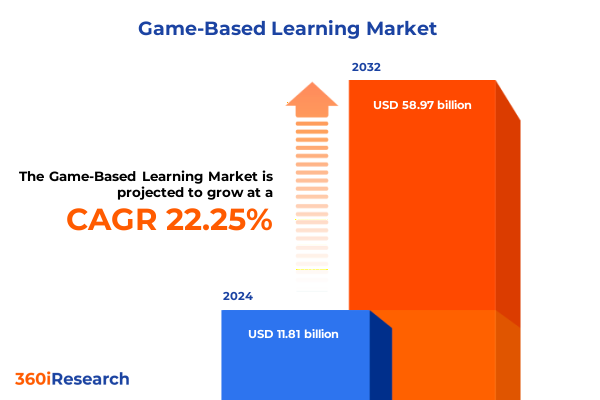The Game-Based Learning Market size was estimated at USD 11.81 billion in 2024 and expected to reach USD 14.45 billion in 2025, at a CAGR of 22.25% to reach USD 58.97 billion by 2032.

Revolutionary Emergence of Game-Based Learning Disrupting Traditional Education Models with Immersive Technologies and Engaging Pedagogies
Game-based learning has rapidly evolved from a niche educational experiment into a foundational driver of instructional innovation, blending the motivational dynamics of gameplay with the rigor of curriculum standards. By leveraging immersive simulations and interactive scenarios, educators and corporate trainers alike have begun to replace passive lecture models with participatory environments that actively engage learners in decision-making and problem-solving. This shift is underscored by a growing recognition that traditional pedagogies often struggle to maintain attention, whereas gamified approaches harness elements such as challenge, feedback loops, and narrative structure to sustain engagement over extended learning cycles.
At the core of this transformation are technological advancements in augmented and virtual reality, artificial intelligence, and cloud infrastructures, which have collectively lowered barriers to adoption and expanded use cases. Recent integrations of AI-driven adaptive learning within virtual reality modules have enabled the delivery of nuanced, personalized feedback, tailoring instructional trajectories in real time to meet individual learner needs, thereby elevating both engagement and efficacy. Meanwhile, the proliferation of mobile AR experiences across smartphones and tablets has democratized access, enabling on-the-go learning scenarios that bridge formal instruction and real-world application, further reinforcing retention and skill transfer. Together, these innovations mark a paradigm shift in how knowledge is acquired, exercised, and assessed, signaling the dawn of a new instructional era.
Unprecedented Transformative Shifts Remapping the Game-Based Learning Landscape through AI Cloud and Next Generation Connectivity
A convergence of cloud computing, next-generation connectivity, and advanced analytics is catalyzing transformative shifts across the game-based learning landscape. Cloud-based development platforms are now enabling real-time deployment of rich 3D environments, eliminating the need for high-end local hardware and supporting seamless updates across geographically distributed teams. As a result, content creators can iterate rapidly on immersive modules, scaling experiences from pilot programs to enterprise-wide rollouts with unprecedented efficiency. This cloud-driven democratization of immersive content is further accelerated by AI-powered authoring tools that streamline asset creation and automate behavior scripting, expediting time to market while preserving pedagogical fidelity.
Comprehensive Analysis of Cumulative Impacts Inflicted by 2025 United States Tariffs on Game-Based Learning Supply Chains and Innovation
The imposition of elevated U.S. tariffs on electronics and technology imports in 2025 has exerted significant pressure on supply chains for hardware-dependent learning platforms. Many interactive flat panels, VR headsets, and specialized training peripherals sourced from China now incur duties approaching 34 percent, compelling providers to explore alternative manufacturing hubs in Southeast Asia and within domestic assembly facilities. These disruptions have also led to increased lead times and sporadic backorders, as schools and corporates rush to secure critical equipment ahead of further policy shifts.
Key Segmentation Insights Revealing Diverse Product Platforms Deployment Modes End Users and Applications Driving Strategic Decision Making
Insights into product type segmentation reveal that augmented reality solutions, differentiated into marker-based and markerless systems, are gaining momentum within corporate and academic environments seeking overlay interfaces for hands-on simulation and remote assistance. Desktop PC platforms continue to serve advanced VR training applications, with Windows systems leading immersive simulation and Mac devices preferred for creative authoring workflows. Mobile tablet platforms, leveraging both smartphones and tablets, are increasingly used for microlearning and remote AR field exercises, while fully immersive virtual reality and semi-immersive configurations cater to high-stakes technical and safety training.
This comprehensive research report categorizes the Game-Based Learning market into clearly defined segments, providing a detailed analysis of emerging trends and precise revenue forecasts to support strategic decision-making.
- Product Type
- Game Type
- Deployment Mode
- Application
- End User
Strategic Regional Insights Highlighting the Unique Dynamics of the Americas Europe Middle East Africa and Asia Pacific Markets
In the Americas, strong investments in digital infrastructure and a corporate focus on upskilling have driven the deployment of cloud-based gamified learning across sectors, from manufacturing to finance. Institutions in North America are piloting hybrid solutions that combine private cloud environments with edge computing to ensure low-latency VR training modules for remote workforces. South American markets are exhibiting a rapid uptake of mobile AR applications, particularly within vocational training programs and language acquisition initiatives.
This comprehensive research report examines key regions that drive the evolution of the Game-Based Learning market, offering deep insights into regional trends, growth factors, and industry developments that are influencing market performance.
- Americas
- Europe, Middle East & Africa
- Asia-Pacific
Exclusive Key Company Insights Illustrating Collaborative Innovations Strategic Partnerships and Competitive Dynamics in Game-Based Learning Industry
Key partnerships are reshaping industry dynamics, exemplified by D2L’s collaboration with Unity to integrate real-time 3D content within managed learning platforms, thus enabling educators to deploy VR and AR modules directly through their LMS. Meanwhile, Minecraft Education’s alliances with Gameplan and Microsoft have expanded esports and coding curricula nationwide, empowering K–12 districts to embed career pathways into engaging gameplay scenarios that develop critical thinking and collaboration skills. These strategic alliances demonstrate a collective drive toward interoperable ecosystems, where platform neutrality and cross-device compatibility are prioritized.
This comprehensive research report delivers an in-depth overview of the principal market players in the Game-Based Learning market, evaluating their market share, strategic initiatives, and competitive positioning to illuminate the factors shaping the competitive landscape.
- 3P Learning Pty Ltd
- Age of Learning, Inc.
- Alphabet Inc
- Amazon Web Services, Inc.
- Banzai Labs Inc.
- BrainPOP LLC
- BrainQuake Inc.
- BreakAway, Ltd.
- BYJU’S Academy of Learning Private Limited
- Cengage Learning, Inc.
- D2L Corporation
- Duolingo, Inc.
- Epic Games, Inc.
- Extramarks Education India Private Limited
- Filament Games, LLC
- Gamelearn S.L.
- Gameloft SE
- Growth Engineering Ltd.
- HealthTap, Inc.
- iCivics, Inc.
- Kahoot! AS
- LearningWare, Inc.
- Lumos Labs Inc.
- Microsoft Corporation
- Mojang AB
- Pearson plc
- PlayGen Ltd
- Pluralsight, Inc.
- Prodigy Education Inc.
- Quizizz Inc.
- Serious Games Interactive
- Skillsoft Corp.
- Stride, Inc.
- WILL Interactive, Inc.
Actionable Strategic Recommendations Empowering Industry Leaders to Harness Emerging Technologies and Navigate Complex Market Challenges in Game-Based Learning
Industry leaders should capitalize on the momentum of interoperability by prioritizing open standards and API-driven integrations that facilitate seamless content exchanges among disparate platforms. By investing in developer ecosystems and certification programs, organizations can cultivate robust creator communities that accelerate the production of high-quality educational experiences. Further, stakeholders should explore subscription-based licensing models that evenly distribute hardware depreciation and content updates over time, reducing upfront budget constraints and promoting long-term adoption.
Robust Research Methodology Outlining Comprehensive Primary and Secondary Data Collection Analytical Approaches and Verification Processes
This research leverages a mixed-methods approach, combining primary interviews with C-suite executives, instructional designers, and technology integrators with extensive secondary analysis of industry reports, peer-reviewed journals, and patent filings. Data triangulation methods were applied to validate thematic patterns, while segmentation matrices were constructed to analyze cross-variables such as product type, deployment mode, end-user profile, and application domain. Quality control measures included peer reviews, expert consultations, and consistency checks against publicly disclosed financial disclosures.
This section provides a structured overview of the report, outlining key chapters and topics covered for easy reference in our Game-Based Learning market comprehensive research report.
- Preface
- Research Methodology
- Executive Summary
- Market Overview
- Market Insights
- Cumulative Impact of United States Tariffs 2025
- Cumulative Impact of Artificial Intelligence 2025
- Game-Based Learning Market, by Product Type
- Game-Based Learning Market, by Game Type
- Game-Based Learning Market, by Deployment Mode
- Game-Based Learning Market, by Application
- Game-Based Learning Market, by End User
- Game-Based Learning Market, by Region
- Game-Based Learning Market, by Group
- Game-Based Learning Market, by Country
- Competitive Landscape
- List of Figures [Total: 30]
- List of Tables [Total: 1539 ]
Compelling Conclusion Synthesizing Critical Findings Strategic Implications and Future Outlook for Game-Based Learning Stakeholders
The synthesis of these findings underscores the emergence of a highly dynamic and resilient game-based learning ecosystem, where technological innovation is met with both opportunity and challenge. While tariff-induced supply constraints necessitate agile sourcing strategies, the twin forces of cloud scalability and AI personalization are driving richer, more adaptable learning experiences. Strategic partnerships and open standards will be critical in sustaining this momentum, ensuring that immersive pedagogy remains accessible and impactful across diverse educational settings.
Engaging Call To Action Inviting Collaboration With Ketan Rohom Associate Director Sales Marketing to Acquire Comprehensive Game Based Learning Market Research Report
To explore the full breadth of transformative insights, comprehensive analyses, and strategic guidance detailed in this report, reach out to Ketan Rohom, Associate Director, Sales & Marketing. Your partnership with Ketan will unlock tailored solutions that align with your specific objectives, empowering your organization to harness the power of game-based learning. Engage today to secure access to the definitive market research, gain competitive clarity, and position your business at the forefront of educational innovation. Take the next step by connecting with Ketan and acquiring the complete Game-Based Learning Market Research Report.

- How big is the Game-Based Learning Market?
- What is the Game-Based Learning Market growth?
- When do I get the report?
- In what format does this report get delivered to me?
- How long has 360iResearch been around?
- What if I have a question about your reports?
- Can I share this report with my team?
- Can I use your research in my presentation?




